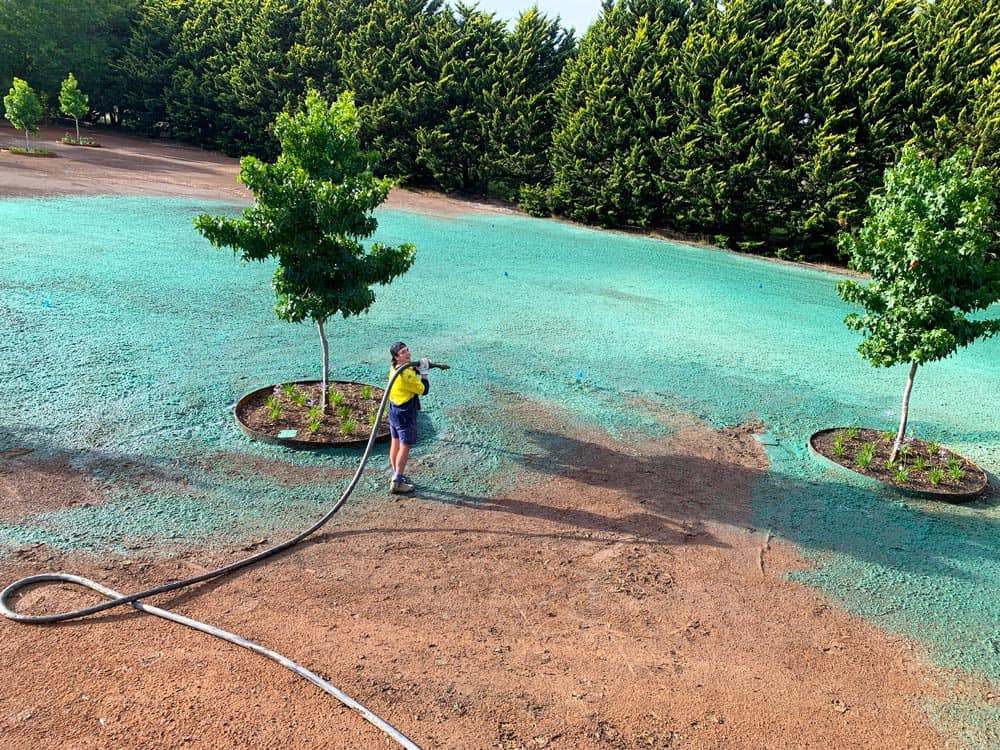New South Wales is home to beautiful natural landscapes, from the Blue Mountains to expansive grasslands However, development and construction often leave scars on the land Erosion control and revegetation are crucial for both environmental and aesthetic reasons. This is where hydroseeding shines as an innovative, efficient and cost-effective solution.
What is Hydroseeding?
Hydroseeding, also called hydraulic mulch seeding, is a planting process that uses a slurry of seeds, mulch and other amendments that is hydraulically sprayed onto prepared soil. It allows you to plant seeds and protective mulch layers over large areas, steep terrain and difficult to reach sites. Hydroseeding is much faster than conventional seeding methods.
The hydroseeding slurry contains a specific mix of seeds, fertilizer, mulch and tackifier. The mulch provides nutrients for seed growth and protects them from drying out. Tackifiers act as an adhesive to bind the mulch layer to the soil surface, preventing it from being washed or blown away. This allows seeds to germinate and establish even with adverse weather.
Benefits of Hydroseeding in NSW
There are many advantages to using hydroseeding for erosion control and revegetation projects in New South Wales
-
Rapid Revegetation – Hydroseeding can cover vast areas exponentially faster than traditional methods. Hundreds of acres can be seeded in a single day. This accelerated process is vital for time-sensitive projects.
-
Cost-Effective – Significant cost savings compared to laying sod or turf grass. Requires less labor, water, and maintenance.
-
Erosion Control – The mulch layer binds and protects the soil, preventing erosion, especially on sloped sites. The tackifier glues the mulch in place.
-
Water Retention – Mulch holds moisture near the seeds, requiring less water for germination and growth. Essential for NSW’s dry climate.
-
Versatility – Hydroseeding can be used on steep, rocky or difficult to access areas. The spray application method is very adaptable.
-
Promotes Growth – The mulch provides nutrients for faster germination. Some mulches can retain 500% of their weight in water.
-
Environmentally Friendly – The slurry can contain native seeds suited for the environment. Causes minimal soil disruption.
Hydroseeding Challenges in New South Wales
While hydroseeding has many benefits, there are also some key challenges when undertaking projects in New South Wales:
-
Climate – Parts of NSW have low and unpredictable rainfall. Lack of moisture makes germination difficult.
-
Soil Quality – Soils may be compacted, eroded or lack nutrients. This inhibits seedling establishment.
-
Steep Slopes – Seeds and mulch can wash away on steep slopes without proper erosion control.
-
Water Access – Adequate water supply is needed nearby for the hydroseeding process and irrigation.
-
Seed Mix – Appropriate grass and plant species must be selected for the local climate and soil conditions.
-
Timing – Seeding at the optimal time of year for the species and weather is crucial.
Best Practices for Hydroseeding Success in NSW
Follow these best practices when hydroseeding in New South Wales for the best results:
-
Conduct soil tests to determine texture, pH and nutrient levels. Address any issues first.
-
Select native grasses and plants adapted to the climate and growing conditions. Avoid invasive species.
-
Use a high-quality mulch that retains moisture and nutrients. Apply the recommended mulch layer depth, often 1-2 inches.
-
Include a long-lasting tackifier to bind the mulch tightly to the soil surface.
-
Seed at the right time of year for the species and expected weather conditions. Spring is ideal for cool season grasses.
-
Ensure adequate water access for the hydroseeding operation and post-germination irrigation.
-
Use temporary erosion control measures like geotextiles while seeds establish.
-
Consider supplemental irrigation if rainfall is insufficient for germination.
-
Be patient as full establishment can take 1-2 growing seasons. Reseed any bare spots.
Why Choose [Company Name] for Your NSW Hydroseeding Project?
With over 25 years of experience, [Company Name] is Australia’s premier provider of innovative hydroseeding solutions. Our team specializes in creating customized hydroseeding mixes using native plant species ideally suited to the unique site conditions across New South Wales.
We conduct extensive soil analysis and climate assessments to engineer the optimal hydroseeding recipe for each project. Our hydroseeding services ensure rapid revegetation and effective erosion control for infrastructure, mining, commercial and municipal projects of any size across NSW.
[Company Name] partners with clients throughout the process, from initial consultation to project completion. We closely monitor progress and proactively advise on any issues to ensure hydroseeding success even in New South Wales’ challenging environments. Contact us today to learn more about our hydroseeding capabilities.

Fast Growth and Erosion Control RIVERINA Hydroseeding
Riverina Hydroseeding provides professional hydroseeding/hydromulching services for fast vegetation growth, erosion control, and eco-friendly landscaping solutions in NSW.
Fastest Way to Plant Large Areas
FAQ
Does hydro seed really work?
Hydroseeding produces superior results because the slurry application encourages deeper roots, helping seeds establish faster and more securely than traditional hand seeding methods. Hydroseed fibers interlock and create a mat that results in strong roots, robust grass growth, and green, healthy, long-lasting grass.
How much does it cost to hydro seed a yard?
Expect to pay around $1,200 to $4,000 for a professionally hydroseeded lawn, depending on size and terrain. Connect with local experts to get the help you need.Apr 10, 2025
When should you hydroseed your lawn?
For fall hydroseeding, as long as you hydroseed 45 days or so before the first expected frost, hydroseeding in the fall can be done with great results, especially if you use cool-season grass seed varieties like Tall or Fine Fescues.
Can you hydro seed over an existing lawn?
The answer is yes, you can hydroseed over an existing lawn, but there are some important factors to consider before doing so.
